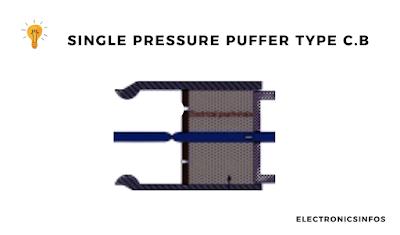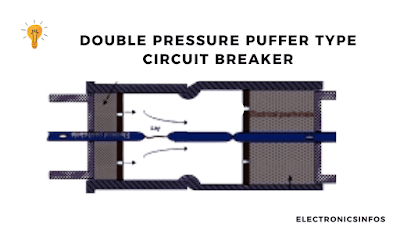What is a Gas Circuit Breaker?
A gas Circuit breaker is a type of circuit breaker in which Sulphur Hexafluoride (SF6) gas is used as an insulating Medium to distinguish the arc.
Over the generations, circuit breakers have evolved from Bulk oil circuit breakers, transitioning to air circuit breakers, Gas Circuit Breakers, and finally vacuum circuit breakers in response to the need for improved system performance.
The different parts of the gas circuit breaker including
Parts of the Gas Circuit breaker
- Line connection
- One-piece epoxy resin enclosure
- Moving contact rod
- Main Moving contacts
- Tungsten alloy arching contacts
- linkage system
- adsorption catalyst
- safety bursting membrane
Working of Gas circuit breaker
- Arc Initiation
- Gas Injection
- Arc Extinction
Construction of Interrupter
There are two types of interrupter W.r.t construction including
- Single Pressure puffer Type C.B
- Double Pressure puffer type C.B
Single Pressure puffer Type C.B
Single-pressure puffer CB consists of a moving cylinder system that is used to compress the gas. when we need to distinguish the arc the grass is released through the single nozzle.
The pressure depends on the Diameter of the nozzle and the speed of the puffer cylinder. The Ratio of P1/p2 becomes 5 times higher in the opening condition.
Double Pressure puffer type C.B
Double pressure puffer C.B. is a type of gas circuit breaker in which gas is entered from high pressure to low pressure. In this puffer system, we improved the pattern of flow. Double Pressure provides a 1.5 times higher braking capacity as compared to a single flow.
In a double flow, the gas flows in a closed circuit. we use an auxiliary tank in which the gas pressure is filled up to 14 kg/cm².
There are different parts of the Double-pressure puffer system isDouble puffer system parts
- Enclosure
- Fixed contact holder
- Puffer cylinder
- Insulating nozzle
- Insulating cap
- path for normal
Advantages of Gas circuit breaker
- Puffer type Circuit breaker is used in the Extra high voltages.
- The physical properties of the gas are good to distinguish the arc.
- The gas is chemically stable to avoid fire.
- The lifetime of SF6 is long.
- The SF6 circuit breaker is noiseless as compared to the air circuit breaker.
- SF6 circuit breaker needs less maintenance.
- There is no current chopping to interrupt the low-value current.
- There are no problem of overvoltages in the C.B.
- SF6 Circuit Breaker is Reliable.
- The installation is easy.
- There is no pollution in the SF6 circuit breaker.
Disadvantages of Gas circuit breaker
- There is no proper sealing in the SF6 Circuit breaker so the chance is available for leakage.
- To transfer, control and maintain the quality we need a special arrangement.
- An insulating gas of gas Circuit breaker is Expensive.
- The double-pressure circuit breaker is expensive and complex in construction.
- We need internal maintenance on the circuit breaker to work well.

%20-%20Electronicsinfos.png)


.png)



0 Comments
please do not insert spam links